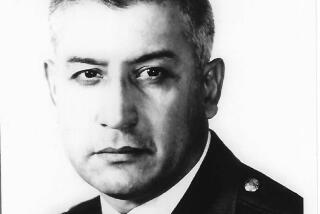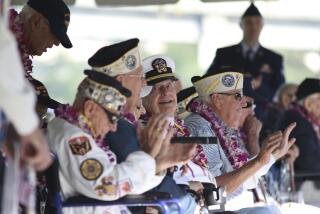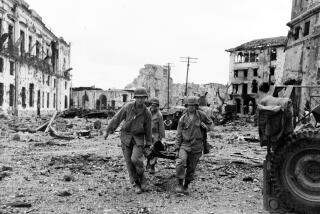They Left World War II as Friendly Enemies : Reunions: Act of ‘courage and chivalry’ endures 45 years and allows an American and a Japanese, foes in the Pacific, to embrace at LAX.
When the World War II buddies saw each other at Los Angeles International Airport Saturday, there were the tears that occasion such reunions. But when they recalled the bad old days, it helped to have a translator nearby, because these old friends were once enemies.
When they met, Jose Holguin was a 23-year-old U.S. Army Air Corps lieutenant, the survivor of a B-17 Flying Fortress crew that was shot down in 1943 by Japanese fighters during a bombing run over Papua New Guinea in the South Pacific.
Torataro Matsumoto was a commandant at the island’s POW camp, where Holguin was imprisoned.
“It’s like a dream,” the 75-year-old Matsumoto said through an interpreter, after the two embraced in the airport terminal. He seemed stunned that the news media, alerted by Holguin, were on hand to record his arrival.
Matsumoto’s visit--his first to the United States--enables Holguin to return a favor. Matsumoto was host to Holguin in Japan in 1986 while Holguin unsuccessfully searched Japanese records, hoping to find the graves of his missing crewmen. His earlier trips to New Guinea and research of American records led to the discovery of a mass grave that contained the remains of five of his crewmen. The remains of four others are still missing.
Holguin feels a debt of gratitude to Matsumoto, remembering him as a “noble” commandant who dipped into his own meager ration of medicine when Holguin and other POWs were stricken with malaria as the result of a crude medical experiment.
Holguin, now a 69-year-old assistant principal at Verdugo Hills High School, is a slightly built, cheerful man whose war souvenirs include a deep scar beneath his chin where shrapnel tore into his jaw, and a scar from a bullet wound on his left leg.
The wounds came in battle. The B-17, christened “The Naughty But Nice,” was careening out of control when the wounded Holguin managed to bail out, fracturing his back as he parachuted into the trees.
The POW camp where he was imprisoned was surrounded by a Japanese garrison of 90,000 men and held as many as 60 prisoners at one point. Holguin was among only seven survivors. Thirty-two were killed in a U.S. bombing raid; the others died of malaria, dysentery and other illnesses.
But Holguin said that he and others may have died if not for Matsumoto. In the spring of 1945, Japanese medical authorities decided to test a theory that some humans possessed a natural immunity to malaria by injecting them with infected blood. Matsumoto voiced objections, but superiors ordered him away from the camp and a doctor proceeded to inject Holguin and four others.
All five contracted malaria, and two test subjects died. The other men expected to die as well.
When Matsumoto returned, he secretly sacrificed his own quinine ration to aid the survivors. This is one reason why Holguin decided to nurture his relationship with Matsumoto over the years, and on Saturday honored Matsumoto with the presentation of an oil portrait made from a photograph of Matsumoto at the age of 30. He penned a dedication citing the old commandant’s “courage and chivalry.”
More to Read
Sign up for Essential California
The most important California stories and recommendations in your inbox every morning.
You may occasionally receive promotional content from the Los Angeles Times.










